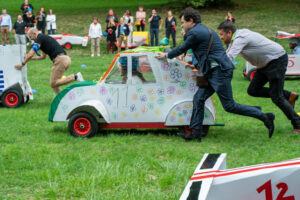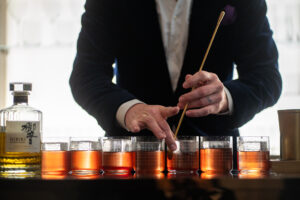The 2025 Guide to Event Photography
In this article :
Event photography is a field of its own within the world of professional photography. It involves capturing a wide range of events, from corporate seminars to product launch parties, including conferences and team-building activities. Unlike studio photography, which relies on full control of visual elements, event photography is more dynamic and unpredictable—making it all the more engaging and valuable for businesses.
This guide offers a comprehensive overview of event photography: from preparation and shooting to equipment management and the specific skills required. Whether you’re a company looking for a photographer for your next event or a professional aiming to refine your expertise in this area, this article will provide practical advice and valuable insights.
What Is Event Photography?
Event photography is about capturing key moments in real time during events. Unlike other types of photography, it doesn’t rely on a controlled environment. This means the photographer must be able to adapt to changing lighting conditions, moving subjects, and the spontaneous nature of interactions.
The goal is to convey the atmosphere of the event—capturing moments of connection, meaningful exchanges, and highlights that define a corporate gathering. This includes speeches, award ceremonies, but also more informal moments such as networking and participant interactions.
Event photography stands out for its dual purpose: both documentary and strategic. It not only preserves memories of the event but also visually communicates a company’s values, culture, and brand image.
Types of Events Covered in Event Photography
Event photographers cover a wide range of occasions, each with its own requirements and characteristics. Common types of events include:
- Seminars and Conferences
These events often feature formal presentations, workshops, and keynote speeches. The photographer must capture key moments, such as speaker interventions and audience engagement. Images from these events are frequently used in reports, presentations, and marketing materials.
- Corporate Meetings and Ceremonies
Whether it’s an award ceremony, a product launch, or an inauguration event, these moments are significant for the company. Photos need to be sharp, well-composed, and reflect the solemn or festive tone of the occasion. - Informal Events and Team-Building Activities
These gatherings emphasize the human side of a company. The photographer’s job is to capture spontaneous interactions, laughter, casual conversations, and candid moments—that help promote team spirit and highlight the people behind the business.
- Professional Evenings and Cocktail Events
These occasions require specific lighting management and a sensitivity to ambiance. The photographer must work with dim lighting and reflective surfaces to create images that convey the relaxed, friendly mood of the event.
- Trade Shows and B2B Exhibitions
These events are more business-focused, centered around networking and showcasing products or services. The photographer should highlight booths, displayed items, and interactions between exhibitors and visitors, while showcasing the overall visual appeal of the event.
How to Get Started in Event Photography
If you’re looking to break into event photography, building a strong portfolio is essential. This can include personal events (such as birthdays or family gatherings) or smaller functions hosted by local businesses. Not only will this help you gain experience, but it will also provide you with compelling images to attract potential clients.
Social media (especially platforms like Instagram) is also a powerful tool for showcasing your work and reaching new clients. You can post images from past events, create engaging stories, or even share client testimonials to build trust and visibility.
Essential Equipment for Event Photography
The gear you use in event photography should be versatile enough to handle a variety of situations. While studio equipment isn’t necessary, having the right tools is crucial to successfully cover different types of events.
- Camera Body: A DSLR or mirrorless camera with strong low-light performance is key. It should also be lightweight enough for easy mobility during long events.
- Lenses: A fast prime lens like a 50mm f/1.4 or a versatile zoom like a 24–70mm allows for portrait shots as well as wider group or scene captures, giving you flexibility in different settings.
- Flash and Accessories: An external flash is a must-have for working in dimly lit environments. Consider using a diffuser to soften the light and avoid harsh shadows.
Your choice of equipment will depend on the types of events you cover, but the most important thing is to have gear that is both reliable and adaptable.
How to Nail the Shot
On the day of the event, the photographer must be prepared to capture key moments while staying unobtrusive. Here are some tips to ensure successful photos:
- Discretion and Presence: A good event photographer knows where to position themselves to catch the right moments without interrupting the flow of the event. Staying in the background and being non-disruptive is essential.
- Interaction and Friendliness: Be approachable and personable. A bit of small talk with guests can help you understand who’s who and anticipate important interactions.
- Vary Your Shots: Don’t stick to one perspective. In addition to classic group photos, capture candid portraits and detail shots that tell the story of the event.
Post-Production and Delivering the Photos
Once the event is over, it’s crucial to manage image delivery efficiently. This means reviewing all photos, sorting them, and ensuring each one is polished and ready to share with the client. This includes selecting the best images, applying light retouching if needed, and adding a watermark or other personalized branding elements.
Offering your clients an online gallery where they can select their favorite images or purchase additional prints is also a great way to add value to your services.
Conclusion
Event photography is a rich and diverse field that captures the key moments in a company’s professional life. Whether it’s a seminar, product launch, or informal gathering, each event requires a unique approach. Event photography not only documents these moments but also helps reinforce a company’s image through high-quality visuals.
At Rétines, we understand the importance of professional photographic coverage for your events. Our experienced photographers capture the essence of every moment, ensuring your photos are not just memories, but powerful communication tools. Because a great event deserves visuals that match its impact, get in touch with us to discuss your next project.
Jérémy Carlo is the editorial director at Rétines, where he ensures the consistency and clarity of all content produced by the studio.
Our Clients
Let’s discuss
What we do for you at Rétines
Meticulous work, an organised project and fast delivery. And to achieve this, we mobilise the right resources in our teams at the right time.
01
Pre-production
Artistic and technical direction tailored to the project.
Relevant recommendations on content, form and resources.
02
Photo Shooting
Photos taken by our experienced photographers.
Production that’s controlled, efficient and tailored to the needs of the project, with nothing superfluous.
03
Retouching
Technique
Photographs magnified by our retouching team.
Post-production to meet the commercial challenges of the brief.












